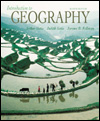 |  Introduction to Geography, 8/e Arthur Getis,
San Diego State University
Judith Getis
Jerome D. Fellmann,
University of Illinois, Urbana-Champaign
Human Impact on the Environment
Objectives:After reading and studying this chapter you should be able to:
1.
Define the three constituent elements of the earth's atmosphere.
|
 |  |  | 2.
Understand the concept of a food chain and be able to trace the passage of elements through one.
|
 |  |  | 3.
Deconstruct the hydrologic cycle into its component processes.
|
 |  |  | 4.
Identify the various types of water pollution, their sources and impacts on the environment.
|
 |  |  | 5.
Identify the sources of air pollution, their specific environmental impact and possible solutions.
|
 |  |  | 6.
Understand the various ways in which human activity modifies landforms, soils and climate.
|
 |  |  | 7.
Identify the primary and secondary effects of soil erosion and the measures currently used to retard or stop
them.
|
 |  |  | 8.
Define and give an example of biological magnification and understand its implications for humans.
|
 |  |  | 9.
Understand the impacts of exotic species, deforestation and use of insecticides on numbers and distribution of
plants and animals.
|
 |  |  | 10.
Identify sources of solid and hazardous wastes and the locational problems associated with current and
proposed methods of their disposal.
|
 |  |  | 11.
To understand why international agreements are needed to prevent the spread of global air pollution.
|
|



 2002 McGraw-Hill Higher Education
2002 McGraw-Hill Higher Education